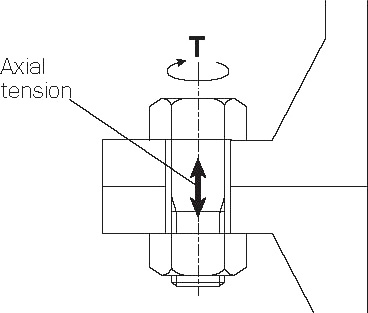What is Torque and Tension?

Torque is twisting or turning force
Tension is the act or process of stretching something tight
Torque is used for creating Tension
Basic Torque Calculations
Torque (T) is shown as the product of the force (F) and the length (L).

= 2F x L/2 (If the force is doubled, halving the length will develop the same torque.)

= F/2 x 2L (If the force is halved, doubling the length will develop the same torque.)
Therefore, a longer lever will require less hand force to produce the same amount of torque.
T1 = F1 x L1 = 10 lbs x 2 ft = 20 ft·lbs
T2 = F2 x L2 = 20 lbs x 1 ft = 20 ft·lbs
T1 = T2
Weight and Mass
Mass will not change anywhere on the earth, even under zero-gravity conditions, while weight is the amount caused by an acceleration that is felt by the body on which the acceleration is acting. In a no gravity zone there is no feeling of weight. The gravity acceleration is different depending on your latitude location on the earth. The weight of an object depends on its mass and the strength of the gravitational pull.
Examples of Force, Mass, and Length Units
- Force Unit: [N] Newton SI Unit (International Standard)
- One Newton [N] (equivalent 0.1[kgf] is the force cause by accelerating a mass of 1kg at 1m/s2
- [kgf] kilogram force) previous Japanese standard units prior to adoption of SI International Standard
- Mass Unit: [kg] kilogram
- Length Unit: [m] meter
Torque Units: SI, Metric and American
Because torque is a product of length and force. The units used to describe torque reference both a force and a length. There are three common torque units: SI (International Standard) based on Newton meters, Metric based on kilogram force centimeters, and American/ English based on inch pounds.
- SI Unit [N.m] Newton meter
- 1000 [nNm]=100 [cNm]=1 [Nm]=0.001 [kNm]
- Metric Unit: [kgf.cm] Kilogram force centimeter
- 1000 [gf.cm.]=1[kgf.cm]=0.01[kgf.m]
- Imperial/American/English Unit: [lbf.in] inch pounds
- 16[ozf.in]=1[lbf.in.]=0.0833[lbf.ft.]
Why Do We Tighten Bolts and Screws?
Fasteners tightening is done in order to stop objects from moving–to fix them. The following are the major objectives of fastener tightening:
- For fixing and joining objects
- For transmitting driving force and braking force
- For sealing drain bolts, gas, and liquid
The fixing force is referred to as axial tension or tightening force and the objective of screw tightening is to apply an appropriate amount of axial tension.
Although axial tension is really what needs to be controlled and measured, it is very difficult to do so, therefore torque is used as a substitute characteristic for administering and controlling tightening operations.
